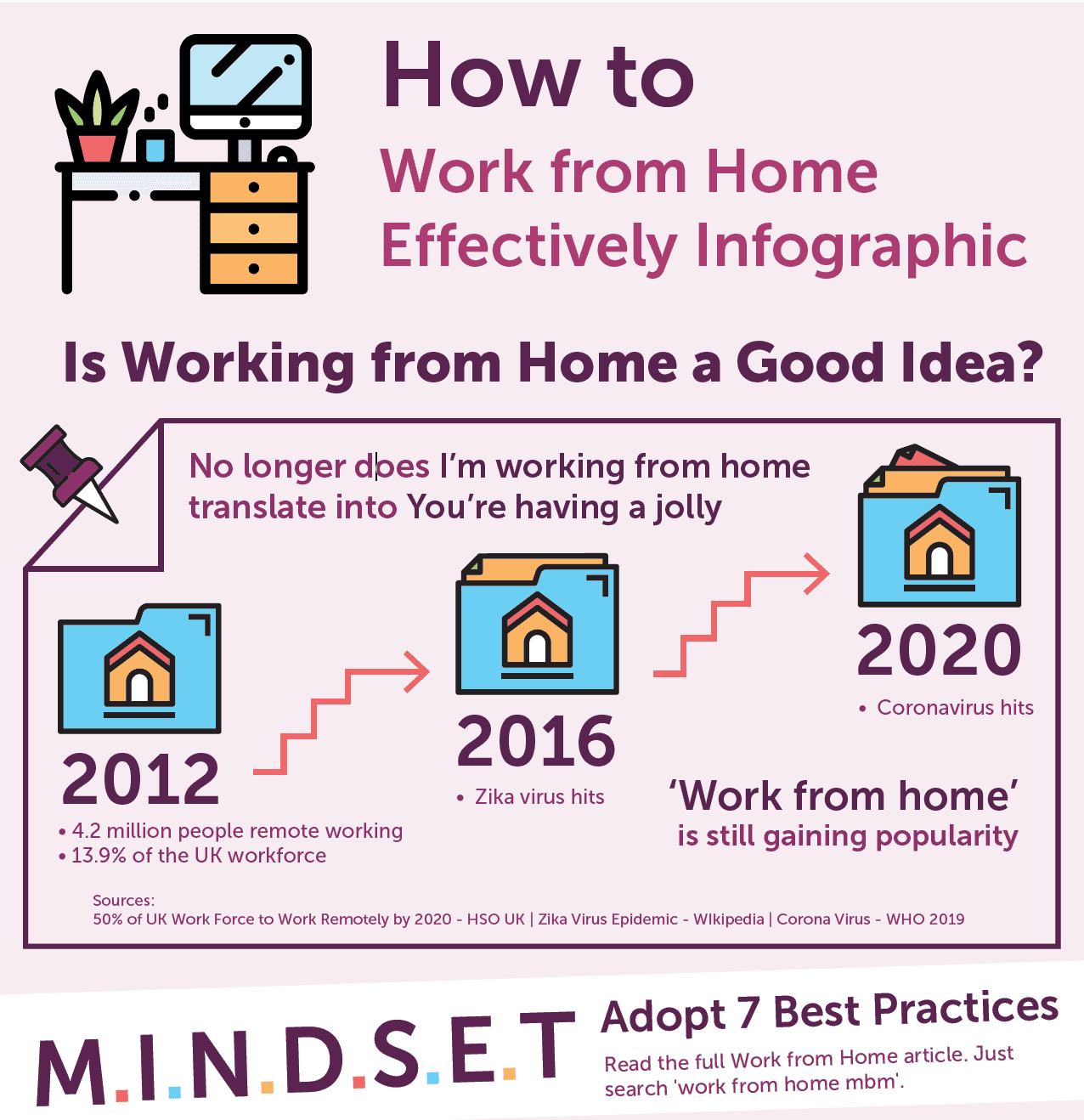Work From Home: Mindset – D is for Deliverables
The fourth letter of our mnemonic M.I.N.D.S.E.T. specifically designed to help you work from home better is ‘D’, Deliverables.
Work From Home: Deliverables Best Practice
- Have a 121 with your line manager. Or line manager, have a 121 with your reports. Agree on SMART targets for the year.
- Invest time to be the very best version of you.
Does Your Line Manager Measure Effort by Hours Worked?
My dad worked hard. He worked for Sainsbury’s. Began – as the story is told – selling rabbits outside a store for 4D (Old money) and worked his way up to retire as Retail Director 40 years later. For a boy from Bethnal Green, he did well. I am proud of what he achieved. In my Dad’s generation, they measured people by how hard they worked and how many hours they worked. If the store manager was in the store at 7 am and left at 8 pm, he did a fair day’s work. If he did that 6 days a week, he’d be promoted. I exaggerate a little, but you get the point.
Unfortunately, today can still be the same. We measure people on how hard they work, in terms of hours, and not always on their results. Although this is changing. The problem remote working brings is that the one thing line managers relied on to asses performance has been taken away. It’s like they were a boxer, and now blindfolded and really having to guess by jabbing in the dark. And how do they guess? By listening and watching every bump and squeak in the night. Looking for what time you logged on and when you sent your first & last email. They know it’s not right. You know it’s not right. But that’s all they have. So, who can blame them? There is another way.
Remote Work Only Magnifies the Problem
The problem is that the faults we have in our People Management Training become magnified when we work remotely. The fault is that we don’t target our people effectively. We agree to lose targets that are not SMART. Performances are still measured subjectively, rather than objectively. More about how we feel than what has actually been achieved.

Of the 7 best practices, this is the key one. Yet, the hardest and the one you’ll fight against most because we have spent years managing people in one way and you’ll not want to change. Change is hard. The question we need to answer with each report is:
Sticky Learning ® is 7 times more effective than 1-day training courses. Plus, you will get a Chain of Evidence proving your Return on Investment. Discover soft skills training that changes behaviours long term.

Why are You on the Payroll?
When we conduct this session in our Time Management Training, people reply with long lists. Lists of things they do at work. But that’s not what we asked. We understand that you do a lot and that you are busy. The question is about what you are here to achieve? Managing customers, sorting deliveries, analysing data, managing categories, etc., etc., etc., is your job. We get that. But what are you paid to make happen? A little like a Rugby player. They train hard. They keep themselves fit. And they study gameplay. Ultimately, they are measured on the tries they get, and the games they are in.
This is where we move from business targets like:
‘Sort out the lamb category.’
…to SMART targets like:
‘Identify 12 opportunities in the lamb category worth £1m each and land them in-store by 31-03-21.’
As a line manager, you almost don’t care if a member of your team works 5 hours per week or 50. If they hit their SMART targets, and those targets are linked to your targets, and your targets are linked to the business, and the business performs well… Who cares? (Not putting aside the mental health challenge of working too many hours per week).
By having SMART targets your 121’s move from tactical discussions about what’s happening and emails sent, to ‘What can I do to help you to identify your third £1m opportunity?’ The performance reviews move from your staff wondering whether they achieved a good grade—which was a surprise on the day of the appraisal. To then know what they achieved before they walk into their Performance Development Review (PDR). And this is because the targets were clear (SMART) and those targets lived and breathed and were discussed throughout the year.
(Click on the image below for the extended version)

A Great Opportunity to Invest in You
Work is tough. You’ve been unbelievably busy. Now you find that you have a little bit more time to get things done. Or as a line manager, we want to help your team to develop when they are working from home.
A google search will show you a million free resources that you can use. The problem is where do you start? and will it actually change your behaviours? Probably not. The best learning experience everyone did, was driving. In learning science, it’s called ‘Spaced repetition‘. I do some learning, take a break, and then do some more. Just like the driving lessons you took. One per week.
Our training is based on a unique training method called ‘Sticky Learning ®.’ We ensure that you not only learn but more importantly that you put into practice what you have learnt as soon as you finish the classroom.
We suggest starting simply. Here’s how:
- Choose one soft skill from this list of 14. From Negotiation Skills to Presentation Skills to Category Management.
- Get two other colleagues interested.
Work From Home ‘D’ – Deliverables Best Practice
- Have a 121 with your line manager. Or line manager, have a 121 with your reports. Agree on SMART targets for the year.
- Invest time to be the very best version of yourself.

Adopt the Other 6 M.I.N.D.S.E.T. Best Practices
Read the main article: How to Work from Home Effectively – M.I.N.D.S.E.T. – Adopt 7 Best Practices.
M is for Manage: Learn how to manage yourself working from home.
I is for Isolation: Find out how NOT to isolate yourself working from home.
N is for Neat: Know why staying in your pyjamas all day will affect how you feel about work.
S is for Space: Getting your own space when you work remotely is very important. Find out how and why.
E is for Emotions: Read about why you need to articulate how you feel.
T is for Technology: Technology is the foundation of your productivity. See how to ensure that it is up to the job.
Contribution from Louise Joyce, Group Sales Training Manager at Arnold Clark
‘I can’t switch off and I work even on holiday. So working from home during lockdown should be a breeze, right? Wrong!
I usually have fires to fight, but now I have time to strategically plan. So to reprogramme my brain, I’m still getting up at 6 am and doing my hair and makeup (especially on a day that involves video calls, to protect the innocent!). I’m keeping in contact with my team and key stakeholders, collating a master to-do list and keeping employees engaged.
Luckily, we have an e-learning system, so we’ll be launching more courses. I give myself time for breaks and acknowledge everyone’s hard work. We can get through this – it’s a great opportunity to achieve without distraction and the possibilities are endless.’
Additional Resources to Help You
LinkedIn is making 16 online courses available free of charge to support people who are new to remote working. Here is the link to the main page:




